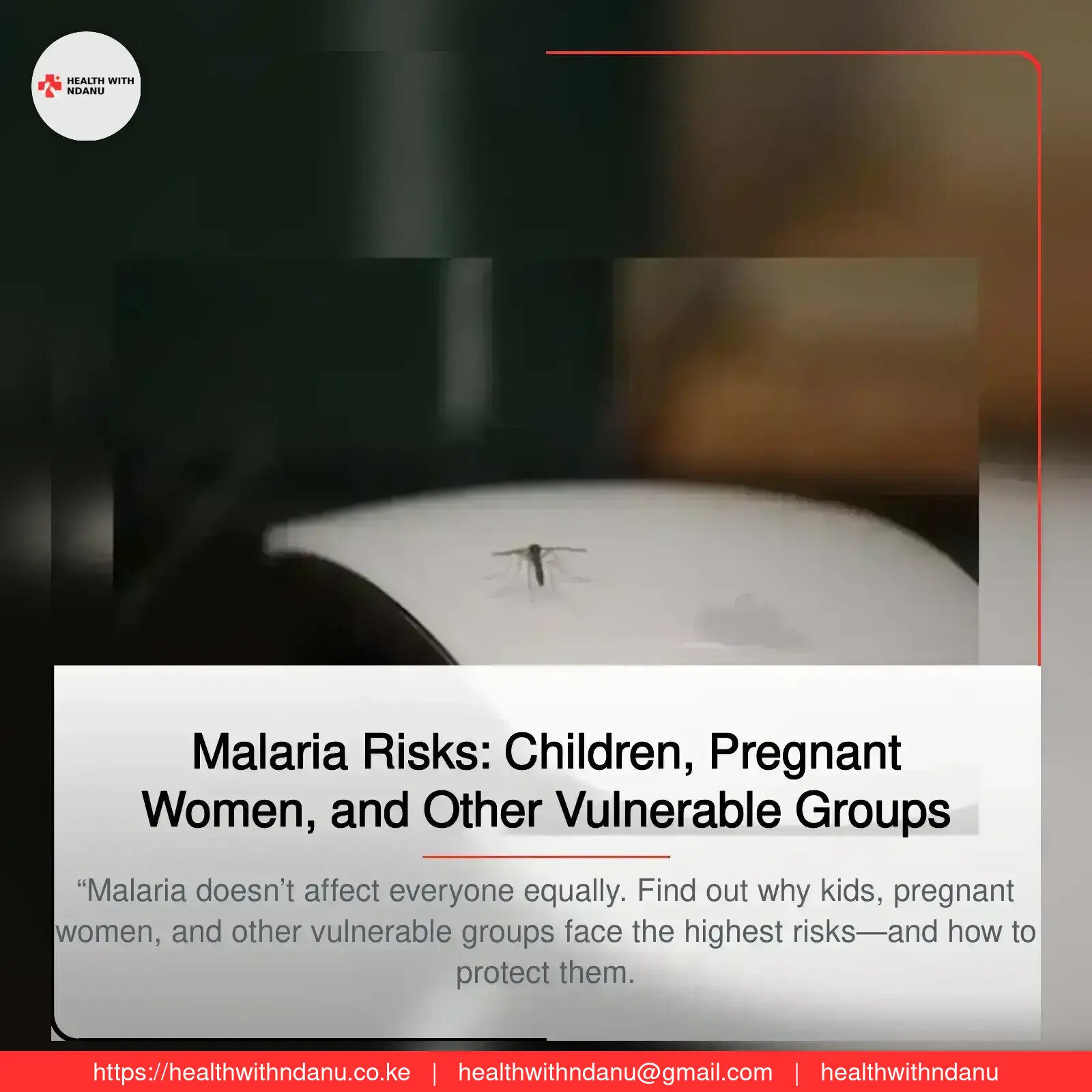Malaria Risks: Children, Pregnant Women, and Other Vulnerable Groups



Introduction
Malaria is a life-threatening disease caused by Plasmodium parasites, transmitted through the bites of infected female Anopheles mosquitoes. Despite being preventable and treatable, malaria remains a major public health concern, particularly in tropical and subtropical regions. The disease affects millions of people annually, leading to severe health complications and deaths, especially among vulnerable groups.
Understanding malaria, its symptoms, and the risks it poses to certain populations is crucial for effective prevention and control. This article will delve into the signs and symptoms of malaria, its impact on high-risk groups, and the best strategies for malaria prevention.
What is Malaria?
Malaria is a vector-borne disease caused by five Plasmodium species, with Plasmodium falciparum and Plasmodium vivax being the most dangerous. The disease spreads through mosquito bites, where parasites enter the bloodstream and attack red blood cells. If untreated, malaria can cause severe complications, including organ failure and death.
Malaria is prevalent in Africa, South Asia, and parts of South America. However, global travel has increased the risk of malaria transmission beyond endemic regions.
Signs and Symptoms of Malaria
Malaria symptoms typically appear 10 to 15 days after infection. The severity varies depending on the Plasmodium species and the individual's immune response.
Common Symptoms of Malaria:
- Fever and chills – Malaria causes cyclic fevers, occurring every 48 to 72 hours, depending on the parasite type.
- Sweating – After fever episodes, excessive sweating occurs as the body's temperature normalizes.
- Severe headache and muscle pain – Common in malaria patients, making daily activities difficult.
- Fatigue and weakness – Caused by the destruction of red blood cells, leading to anemia.
- Nausea, vomiting, and diarrhea – Some people experience gastrointestinal symptoms alongside fever.
- Jaundice – Yellowing of the skin and eyes due to liver complications.
- Seizures and confusion – A sign of cerebral malaria, which can lead to coma and death if untreated.
Recognizing these symptoms early and seeking medical attention is crucial to preventing complications.
Dangers of Malaria to Special Groups in Society
While malaria affects people of all ages, certain populations are at a higher risk of severe complications and death. These vulnerable groups require special attention in malaria prevention and treatment.
1. Pregnant Women and Malaria
Pregnant women are highly susceptible to malaria due to immune system changes. Malaria during pregnancy can cause:
- Maternal anemia, increasing the risk of complications during childbirth.
- Low birth weight and preterm birth, affecting the baby's survival and long-term health.
- Stillbirth or miscarriage, particularly in areas with high malaria transmission.
- Placental malaria, where parasites infect the placenta, restricting oxygen and nutrient supply to the fetus.
To prevent malaria in pregnancy, the World Health Organization (WHO) recommends intermittent preventive treatment (IPTp) with sulfadoxine-pyrimethamine (SP) and the use of insecticide-treated nets (ITNs).
2. Infants and Young Children
Children under five years old are among the most vulnerable to malaria. Their immune systems are not fully developed, making them more susceptible to severe infections. Malaria in children can cause:
- Severe anemia, leading to fatigue, weakness, and increased risk of infections.
- Cerebral malaria, a life-threatening complication that causes brain swelling, seizures, and coma.
- Rapid progression to severe illness, increasing the likelihood of death if untreated.
Vaccination programs, such as the RTS,S malaria vaccine, are being introduced to protect children in high-risk regions. Early diagnosis and prompt treatment with artemisinin-based combination therapies (ACTs) are essential in managing pediatric malaria cases.
3. Elderly Individuals
Older adults, especially those with chronic illnesses, have a higher risk of malaria complications due to weakened immune systems. Malaria in the elderly can lead to:
- Organ failure, particularly affecting the liver, kidneys, and lungs.
- Prolonged recovery, making them susceptible to other infections.
- Higher fatality rates, especially in those with diabetes, hypertension, or cardiovascular diseases.
4. People with Weakened Immune Systems
Individuals with compromised immunity, such as those living with HIV/AIDS, cancer patients undergoing chemotherapy, or organ transplant recipients, face increased malaria risks. In these individuals, malaria can:
- Worsen existing infections, making treatment more complicated.
- Prolong illness, reducing treatment efficacy.
- Increase the risk of death, as the immune system struggles to fight the infection.
- Preventive measures, such as prophylactic antimalarial drugs and consistent mosquito control strategies, are essential for these groups.
5. Travelers from Non-Endemic Areas
People traveling from malaria-free regions (e.g., tourists, expatriates, business travelers) lack immunity to malaria, making them highly susceptible. Travelers should take precautions, including:
- Taking antimalarial medications before, during, and after travel.
- Using insect repellents and mosquito nets to prevent bites.
- Wearing long-sleeved clothing to minimize exposure.
Malaria Prevention and Control Measures
Malaria prevention requires a combination of strategies to reduce transmission and protect vulnerable populations. Effective malaria control measures include:
1. Use of Insecticide-Treated Mosquito Nets (ITNs)
Sleeping under ITNs significantly reduces mosquito bites and malaria transmission. ITNs provide a protective barrier and kill mosquitoes on contact.
2. Indoor Residual Spraying (IRS)
IRS involves spraying insecticides inside homes to kill mosquitoes. This method is highly effective in malaria-endemic areas.
3. Antimalarial Medications
Prophylactic drugs – Travelers and high-risk individuals should take preventive malaria medications, such as doxycycline, atovaquone-proguanil, or mefloquine.
Artemisinin-based combination therapies (ACTs) – The WHO-recommended first-line treatment for uncomplicated malaria.
4. Eliminating Mosquito Breeding Sites
- Draining stagnant water – Mosquitoes breed in water; eliminating stagnant pools reduces their population.
- Using larvicides – Applying larvicidal chemicals to water bodies prevents mosquito larvae from developing.
5. Early Diagnosis and Prompt Treatment
Rapid diagnostic tests (RDTs) and blood smear microscopy help in the early detection of malaria. Timely treatment prevents severe complications and reduces malaria-related deaths.
Conclusion
Malaria remains a global health challenge, particularly for pregnant women, young children, the elderly, immunocompromised individuals, and non-immune travelers. Recognizing malaria symptoms and taking preventive measures can help reduce the disease burden.
Public health efforts, community education, and improved access to healthcare services are essential in combating malaria. By adopting effective malaria control strategies, we can work towards a malaria-free future and protect high-risk populations from the devastating effects of this disease.
Got Your Own Experience? Share with us
Kategoria Maarufu
Blogu Zinazotembelewa Zaidi
Daily Newsletter
Get all the top stories from Blogs to keep track.



